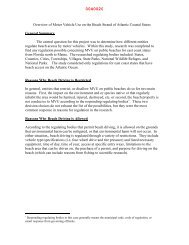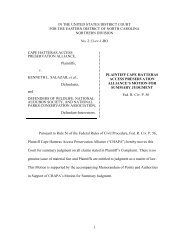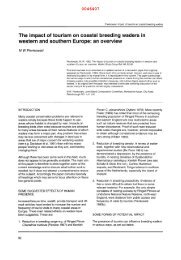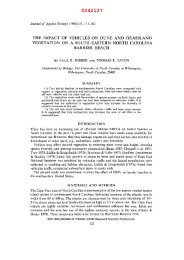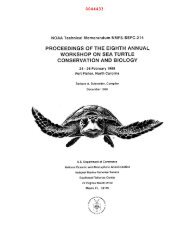Buffer Zone Distances to Protect Foraging and Loafing Waterbirds ...
Buffer Zone Distances to Protect Foraging and Loafing Waterbirds ...
Buffer Zone Distances to Protect Foraging and Loafing Waterbirds ...
You also want an ePaper? Increase the reach of your titles
YUMPU automatically turns print PDFs into web optimized ePapers that Google loves.
0048818<br />
BUFFER ZONE DISTANCES 139<br />
Royal terns flushed from a loafing site on Florida coast. Pho<strong>to</strong> hy S. A. Nesbitt.<br />
<strong>Buffer</strong> zone distanees <strong>to</strong> proteet foraging<br />
<strong>and</strong> loafng waterbrds from hman<br />
disturbance in lori da<br />
James A. Rodgers, Jr., <strong>and</strong> Henry T. Smith<br />
Abstract Sixteen species of waterbirds (Pelecaniformes, Ciconiiformes, Charadriiformes) in north<br />
<strong>and</strong> central Florida were exposed <strong>to</strong> 4 types of human disturbances (walking, all-terrain vehicle,<br />
au<strong>to</strong>mobile, boat) <strong>to</strong> determine buffer zones that minimize flushing of foraging or<br />
loafing birds. Both intraspecific <strong>and</strong> interspecific variation were observed in flushing-response<br />
distances <strong>to</strong> the same type of disturbance. <strong>Buffer</strong> zones were estimated using a formula<br />
based on the mean plus 1 .6495 st<strong>and</strong>ard deviations of the observed flushing distance<br />
plus 40 m (buffer distance = exp [At + 1 .6495cr] + 40). A buffer of about 1 00 m should minimize<br />
disturbance <strong>to</strong> most species of waterbirds we studied in Florida. We recommend follow-up<br />
studies <strong>to</strong> test our buffer distances for other species <strong>and</strong> disturbance situations.<br />
Key words all-terrain vehicle, au<strong>to</strong>mobile, buffer zone, Charadriiformes, Ciconiiformes, Florida, guidelines,<br />
mo<strong>to</strong>r boat, pedestrian traffic, Pelecaniformes, set-back distance, shorebirds, waterbirds<br />
Wildlife disturbance <strong>and</strong> harassment may reduce mented <strong>and</strong> human disturbances increase, more skitspecies<br />
diversity <strong>and</strong> density at the l<strong>and</strong>scape or re- tish species may find it difficult <strong>to</strong> secure adequate<br />
gional scale (Boyle <strong>and</strong> Samson 1985, Cole <strong>and</strong> food or loafing sites (Skagen et al. 1991, Pfister et al.<br />
Knight 1990). As foraging habitat becomes frag- 1992). Conflicts arise because many aquatic habitats<br />
Address for James A. Rodgers, Jr.: Wildlife Research Labora<strong>to</strong>ry, Florida Game <strong>and</strong> Fresh Water Fish Commission, 4005 South Main<br />
Street, Gainesville, FL 32601, USA. Address for Henry T. Smith: Florida Department of Environmental <strong>Protect</strong>ion, Florida Park Service,<br />
13798 S.E. Federal Highway, Hobe Sound, FL 33455, USA.<br />
Wildlife Society Bulletin 1997, 25(1):139-145 Peer refereed
0048819<br />
140 Wildlife Society Bulletin 1997, 25(1):1 39-145<br />
used by foraging waterbirds (e.g., shorelines, area for providing resident waterbird habitat, winter<br />
beaches, s<strong>and</strong>bars, isl<strong>and</strong>s) are attractive <strong>to</strong> outdoor shorebird refugia, <strong>and</strong> staging areas for migrating<br />
recreationists. For example, Burger (1981) found a species along both coasts. Pedestrian, all-terrain vereduced<br />
number of shorebirds near people who hicle (ATV), au<strong>to</strong>mobile, <strong>and</strong> boat traffic are the most<br />
were walking or jogging <strong>and</strong> about 50% of flushed frequent forms of human disturbance <strong>to</strong> waterbirds<br />
birds were forced elsewhere. Boyle <strong>and</strong> Samson in Florida, especially at coastal sites.<br />
(1985) found wildlife observers were especially disturbing<br />
<strong>to</strong> animals because of the frequency <strong>and</strong> duration<br />
of their visits. Human disturbances can indi-<br />
Study area<br />
rectly (Skagen et al. 1991, Pfister et al. 1992) or We collected data for 9 species of wading birds<br />
overtly (Knight <strong>and</strong> Skagen 1988, Cole <strong>and</strong> Knight (Pelecaniformes spp., Ciconiiformes spp.) <strong>and</strong> 7<br />
1990) disrupt wildlife community dynamics. species of shorebirds (Charadiiformes spp.) at 24 ar-<br />
Several studies have suggested that distance <strong>to</strong> hu- eas in north <strong>and</strong> central Florida (Table 1). Sites were<br />
man disturbance was a major fac<strong>to</strong>r in determining if chosen r<strong>and</strong>omly with a mix of low, moderate, <strong>and</strong><br />
<strong>and</strong> when birds flushed <strong>and</strong> recommended not ap- high amounts of human activity.<br />
proaching wildlife or reducing the frequency of disturbances<br />
(Burger 1981; Belanger <strong>and</strong> Bedard 1989;<br />
Burger <strong>and</strong> Gochfeld 1991a,b; Grubb <strong>and</strong> King 1991;<br />
Methods<br />
Klein 1993; Roberts <strong>and</strong> Evans 1993). Burger <strong>and</strong> Data were collected intensively during 1989-1992<br />
Gochfeld (1991a) found foraging time of s<strong>and</strong>erlings <strong>and</strong> intermittently during 1994-1995. Four types of<br />
(Calidris alba) decreased <strong>and</strong> avoidance (e.g., run- human disturbance were used <strong>to</strong> elicit flushing rening,<br />
flushing) near human activities increased as the sponses: (1) walking (continuous [1 step/sec], direct<br />
number of humans within 100 m increased. Knight approach by 1-2 people on foot); (2) all-terrain vehi<strong>and</strong><br />
Knight (1984) suggested that flight distances of cle (continuous [2.5 m/sec], direct approach by 2<br />
birds flushed by different types of disturbances could people on a red 350-cc, 4-wheel ATV [noise level<br />
be used <strong>to</strong> develop zones for restricting human activ- 75-80 dBA]); (3) au<strong>to</strong>mobile (continuous [2.5<br />
ities. Such buffer zones or set-back distances are 1 m/sec], direct approach by 2 people in a green halfstrategy<br />
<strong>to</strong> minimize effects of human disturbance <strong>to</strong> <strong>to</strong>n truck [noise level 70-75 dBA]); <strong>and</strong> (4) mo<strong>to</strong>rwildlife<br />
(Erwin 1989, Rodgers <strong>and</strong> Smith 1995). Pre- boat (continuous [0.5-1.0 m/sec], direct approach<br />
vious recommendations for buffer zones <strong>to</strong> protect by 2 people in an olive-green 4.3-m [14 feet], aluwaterbirds<br />
have been primarily implemented around minum jon-boat with a 30-hp outboard mo<strong>to</strong>r [noise<br />
breeding colonies <strong>and</strong> have ranged from 50 <strong>to</strong> 200 m level 80-85 dBA]). Because it was difficult <strong>to</strong> quanfor<br />
tern (Sterninae spp.; Buckley <strong>and</strong> Buckley 1976, tify the initial alert response distance <strong>to</strong> a distur-<br />
Erwin 1989, Rodgers <strong>and</strong> Smith 1995) <strong>and</strong> from 100 bance, we used the more readily detected <strong>and</strong> easily<br />
<strong>to</strong> 250 m for wading bird (Ardeidae spp.; Vos et al. measured flushing distance as an index of distur-<br />
1985, Erwin 1989, Rodgers <strong>and</strong> Smith 1995). Al- bance. Flushing distance was defined as the distance<br />
though Florida began using buffer zones <strong>to</strong> protect from the observer <strong>to</strong> the bird at the moment it actuwaterbird<br />
nesting sites from human disturbances in ally began movement away from the approaching dis-<br />
1976, distances of buffer zones used by natural re- turbance. When approaching a group of birds, we<br />
source personnel <strong>to</strong> protect breeding colonies have measured distance from the first bird in the group <strong>to</strong><br />
only recently been developed on the basis of regional flush. The distance between the observer <strong>and</strong> the<br />
empirical data <strong>and</strong> recommendations (Rodgers <strong>and</strong> bird was measured in meters using optical range find-<br />
Smith 1995). However, no specific recommenda- ers with calibrated accuracies of ?0.5 m (30 m).<br />
disturbance <strong>to</strong> foraging <strong>and</strong> loafing birds.<br />
We restricted data collection <strong>to</strong> between 0700-<br />
Our objective was <strong>to</strong> recommend buffer distances 1600 hours on clear <strong>to</strong> partly cloudy days, with wind<br />
that minimize human disturbance <strong>to</strong> foraging <strong>and</strong> conditions
0048820<br />
<strong>Buffer</strong> zone distances e Rodgers <strong>and</strong> Smith 141<br />
Table 1. Study areas in Florida where flush distances were measured in response <strong>to</strong> 4 types of disturbances.<br />
Relative impact<br />
Site Habitat description Disturbance type of human activity<br />
Amelia Isl<strong>and</strong> Beach shoreline Walk, all-terrain Moderate<br />
Anastasia Isl<strong>and</strong> Beach shoreline All-terrain Moderate<br />
Crescent Beach Beach shoreline Au<strong>to</strong>mobile High<br />
Dee Dot Ranch Freshwater lake shoreline Au<strong>to</strong>mobile, boat Low<br />
Ft. Pierce Coastal s<strong>and</strong>bar Walk, boat Low<br />
Gainesville Isolated freshwater marshes Walk Low<br />
Haulover Coastal marshes <strong>and</strong> shoreline Walk, boat Low<br />
Huguenot Beach Beach shoreline Walk, all-terrain Low<br />
Lake Kissimmee Freshwater lake shoreline Walk, boat Low<br />
Lake Jackson Freshwater lake shoreline Walk Low<br />
Matanzas Beach Beach shoreline Walk, all-terrain Moderate<br />
Merritt Isl<strong>and</strong> Coastal marshes <strong>and</strong> shoreline Walk, au<strong>to</strong>mobile Moderate<br />
Ochlocknee Bay Coastal <strong>and</strong> freshwater marshes Walk Low<br />
Pelican Isl<strong>and</strong> Coastal isl<strong>and</strong> shoreline Walk, boat Low<br />
Phipps Point Coastal shoreline Walk Low<br />
Ponte Vedra Beach Beach shoreline Walk, all-terrain High<br />
Port Orange Coastal shoreline Walk, boat Moderate<br />
St. Augustine Coastal shoreline Boat Moderate<br />
St. Augustine Beach Beach shoreline All-terrain, au<strong>to</strong>mobile High<br />
St. George Isl<strong>and</strong> Causeway shoreline Walk Low<br />
St. Marks Coastal marshes Walk Low<br />
Tallahassee Isolated freshwater ponds Walk Low<br />
Tampa Bay Coastal shoreline Walk, boat Moderate<br />
Vilano Beach Beach shoreline Walk, all-terrain High<br />
age classes, <strong>and</strong> types of disturbances (i.e., not all the remaining 6 had right-skewed data. Log transforcombinations<br />
were represented by sample sizes mation normalized the data for these 6 species.<br />
?10). We plotted empirical quantiles against the Residuals from an ANOVA model plotted against the<br />
quantiles of a st<strong>and</strong>ard normal distribution <strong>and</strong> his- predicted values yielded a r<strong>and</strong>om scatter that sug<strong>to</strong>grams<br />
for untransformed flushing distances for gested homogeneity of variance for the log-transspecies<br />
with ?10 observations using the UNIVARI- formed flushing distances.<br />
ATE procedure (SAS Inst., Inc. 1990). The Shapiro- We used an ANOVA/Fisher's protected least-signifi-<br />
Wilk statistic was used <strong>to</strong> test whether the data were cant-difference test on subsets (i.e., species x disturnormally<br />
distributed for each species x disturbance. bance, species x species x disturbance, species x age<br />
Ten of 16 species had normally distributed data, but class x disturbance) <strong>to</strong> test for differences in flushing<br />
distances among species for the same type of disturbance.<br />
We were able <strong>to</strong> collect enough data for 3<br />
species <strong>to</strong> compare flushing distances between adults<br />
<strong>and</strong> subadults <strong>to</strong> a walking approach. No significant<br />
differences (t-test, P > 0.05) were detected between<br />
adult <strong>and</strong> subadult brown pelican (Pelecanus occidentalis),<br />
little blue heron (Egretta caerulea), <strong>and</strong> tricolored<br />
heron (E. tricolor) age classes. Thus, we<br />
I _~~~~~~~<br />
pooled data for these species <strong>and</strong> did the same for<br />
other age classes of species with n < 10. However,<br />
significant differences among the species x disturbance<br />
prevented pooling these data (Table 2).<br />
We recommended buffer distances for individual<br />
species using the mean <strong>and</strong> st<strong>and</strong>ard deviation of<br />
sampled populations (Rodgers <strong>and</strong> Smith 1995). Because<br />
of concurrent activity of other birds or reac-<br />
Black skimmer loafing <strong>and</strong> shorebirds foraging at a coastal site in<br />
Florida. Pho<strong>to</strong> by S. T. Schwikert.<br />
tions <strong>to</strong> prey, we could not always determine when<br />
the bird under observation first exhibited a response
0048821<br />
142 Wildlife Society Bulletin 1997, 25(1):139-145<br />
Table 2. Flush distances <strong>and</strong> recommended buffer distances for nonbreeding waterbirds reacting <strong>to</strong> 4 types of human disturbances.<br />
Flush distance (m)<br />
Disturbance Species n x SD<br />
Recommended<br />
buffer (m)b<br />
Walking Brown pelican (Pelecanusoccidentalis) 21 27.38 14.77 A B 107<br />
Double-crested cormorant (Phalacrocorax auritus) 15 31.27 12.90 A B 102<br />
Greatblue heron (Ardea herodias) 18 30.57 12.39 A B 100<br />
Greategret(Ardea alba) 28 30.55 9.62 A B 91<br />
Littleblue heron (Egretta caerulea) 18 23.02 14.29 A B 104<br />
Snowy egret (Egretta thula) 19 26.81 9.27 A B 87<br />
Tricolored heron (Egretta tricolor) 24 24.09 8.18 A B 82<br />
Willet(Ca<strong>to</strong>ptrophorussemipalmatus) 12 20.61 6.26 B C 74<br />
S<strong>and</strong>erling (Calidris alba) 13 13.73 4.88 C 67<br />
Ring-billed gull (Larus delawarensis) 12 33.80 8.42 A 91<br />
Black skimmer (Rynchops niger) 29 26.63 8.33 A B 85<br />
All-terrain vehicle Semipalmated plover (Charadrius semipalmatus) 24 19.95 7.24 B 76<br />
Willet(Ca<strong>to</strong>ptrophorussemipalmatus) 30 19.27 6.41 B C 73<br />
Ruddy turns<strong>to</strong>ne (Arenaria interpres) 35 14.80 6.82 C 72<br />
S<strong>and</strong>erling(Calidrisalba) 39 14.97 6.10 B C 69<br />
Ring-billed gull (Larus delawarensis) 20 31.84 12.70 A 101<br />
Au<strong>to</strong>mobile Western s<strong>and</strong>piper (Calidris mauri) 44 18.66 4.45 B 68<br />
Willet (Ca<strong>to</strong>ptrophorus semipalmatus) 25 24.24 6.19 A 77<br />
Ring-billed gull (Larus delawarensis) 36 22.04 9.30 A B 84<br />
Mo<strong>to</strong>r boat Brown pelican (Pelecanus occidentalis) 22 34.48 1 9.1 7 A B 126<br />
Anhinga(Anhingaanhinga) 12 37.40 17.40 A 120<br />
Greategret (Ardea alba) 11 36.05 13.60 A B 107<br />
Wood s<strong>to</strong>rk (Mycteria americana) 19 26.47 5.49 B 77<br />
a Means with the same letter, within the same disturbance type, are not different (P > 0.05, ANOVA, Fisher's protected least significant<br />
difference test).<br />
b<strong>Buffer</strong> distance was calculated by using the formula: distance = exp (jl + 1.6495 &) + 40 m. Values were rounded <strong>to</strong> the nearest<br />
meter.<br />
<strong>to</strong> our disturbance. Based on our previous observa- dard deviation for the observed values of Y1 = in (X.),<br />
tions from blinds (Rodgers <strong>and</strong> Smith 1995), single i = 1, . . . , n, <strong>and</strong> ZO 95was the 0.95 quantile of a stanbirds<br />
approached by a walking person became alert dard normal variable (i.e., ZO95 = 1.6495). We believe<br />
25-40 m prior <strong>to</strong> flushing. The addition of 40 m <strong>to</strong> that the 95% criterion provides a sufficiently conservthe<br />
flushing distances of our sampled populations ative margin in the establishment of buffer zones for<br />
would be a conservative approach <strong>to</strong> minimize ago- waterbirds.<br />
nistic responses by birds <strong>and</strong> take in<strong>to</strong> consideration<br />
the suggestion by Thompson <strong>and</strong> Thompson (1985)<br />
that mixed-species assemblages are more vigilant <strong>and</strong><br />
Results<br />
skittish than single-species groups.<br />
Walk approach<br />
<strong>Buffer</strong> distances were derived in the following man- Ring-billed gulls (Larus delawarensis) had the<br />
ner. For a given species, let Xi represent the observed largest mean flushing distance (x = 33.80 m) <strong>and</strong><br />
flushing distance for an individual approach i, <strong>and</strong> Y1 s<strong>and</strong>erlings had the smallest mean (x = 13.73 m)<br />
= ln(X,). We assumed that the Xi were independent, among 11 species exposed <strong>to</strong> a walk approach (Table<br />
identically distributed, <strong>and</strong> followed a lognormal dis- 2). There was a tendency for shorebirds (e.g., s<strong>and</strong>ertribution<br />
with parameters u <strong>and</strong> a such that y = E(Y1) ling, willet) <strong>to</strong> flush at shorter distances <strong>and</strong> pelecan<strong>and</strong><br />
'2 = var(Y1). The desired buffer distance was de- iform <strong>and</strong> ciconiiform birds <strong>to</strong> flush at longer disfined<br />
as the upper limit of an approximate 95% 1- tances.<br />
sided confidence interval for E(X) + 40 m. That is<br />
ATV approach<br />
buffer distance = exp ( + ZO95 ) + 40 m, Ring-billed gulls exhibited the largest mean flushing<br />
distance (x = 31.84 m), whereas ruddy turns<strong>to</strong>nes<br />
where At was the sample mean <strong>and</strong> a was the stan- (Arenaria interpres) had the smallest mean (x =
14.80 m) among the 5 species exposed <strong>to</strong> an ATV ap-<br />
proach (Table 2). As in the walk approach, ring-<br />
billed gulls had the largest mean flushing distance<br />
among the species sampled.<br />
Au<strong>to</strong>mobile approach<br />
Willets (Ca<strong>to</strong>ptropborus semipalmatus) exhibited<br />
the largest mean flushing distance (x = 24.24 m),<br />
whereas western s<strong>and</strong>pipers (C. mauri) had the<br />
smallest mean (x = 18.66 m) among the 3 species exposed<br />
<strong>to</strong> an au<strong>to</strong>mobile approach (Table 2).<br />
0048822<br />
<strong>Buffer</strong> zone distances * Rodgers <strong>and</strong> Smith 143<br />
|~ 'L<br />
Boat approach<br />
Anhingas (Anhinga anhinga) exhibited the largest<br />
<strong>Foraging</strong> <strong>and</strong> loafing wood s<strong>to</strong>rks at a coastal site in Florida.<br />
mean flushing distance (x = 37.40 m) <strong>and</strong> wood Pho<strong>to</strong> by S. A. Nesbitt.<br />
s<strong>to</strong>rks (Mycteria americana) had the smallest mean<br />
(x = 26.47 m) among the 4 species exposed <strong>to</strong> a boat tances (Rodgers <strong>and</strong> Smith 1995) while nesting <strong>and</strong> asdisturbance<br />
(Table 2).<br />
sociation with human activities along Florida's coasts.<br />
Burger (1981) also reported interspecific variation<br />
Comparisons among disturbance among waterbirds: she suggested gulls <strong>and</strong> temns were<br />
methods<br />
the least disturbed of the species studied possibly due<br />
There were no significant (t-test, P > 0.05) differ- <strong>to</strong> habituation <strong>to</strong> human activities, while herons <strong>and</strong><br />
ences in the flushing distances of brown pelicans <strong>to</strong> other shorebirds were more easily flushed possibly<br />
boat (x7 = 34.48 m) <strong>and</strong> walk (x7 = 27.38 m) ap- because they were migrant species that rarely interproaches<br />
or in s<strong>and</strong>erlings <strong>to</strong> ATV (x = 14.97 m) <strong>and</strong> acted with humans. Differences in Burger's (1981)<br />
walk (x = 13.73 m) approaches. Willets exhibited no <strong>and</strong> our observations regarding flushing distances of<br />
significant (t-test, P > 0.05) difference <strong>to</strong> au<strong>to</strong>mobile shorebirds suggest regional differences in species' re-<br />
(x = 24.24 m) <strong>and</strong> walk (x = 20.61 m) approaches, sponses <strong>to</strong> similar disturbances or habituation along<br />
<strong>and</strong> between walk <strong>and</strong> ATV (xA = 19.27 m) ap- migra<strong>to</strong>ry routes. We also did not observe shorter<br />
proaches, but there was a significant (t-test, P < 0.05) flushing distances for larger species of birds in Florida<br />
difference between au<strong>to</strong>mobile <strong>and</strong> ATV approaches. as reported by Burger <strong>and</strong> Gochfeld (199Wb) in India.<br />
Ring-billed gulls exhibited the most variation in flush- We compared the flushing distances of foraging<br />
ing distances <strong>to</strong> the 4 types of disturbances. Whereas <strong>and</strong> loafing birds with the results of our previous<br />
no significant (t-test, P > 0.05) difference was de- study of nesting birds (Rodgers <strong>and</strong> Smith 1995).<br />
tected between walk (xT = 33.80 m) <strong>and</strong> ATV (xT = Three of 9 species comparisons (walk <strong>to</strong>wards dou-<br />
31.84 m) approaches, there was a significant (t-test, P ble-crested cormorants [Phalacrocorax auritus],<br />
< 0.05) difference between au<strong>to</strong>mobile (xT = 22.04 m) great blue herons [Ardea berodias], <strong>and</strong> great egrets<br />
<strong>and</strong> ATV approaches <strong>and</strong> between walk <strong>and</strong> au<strong>to</strong>mo- [A. alba]) were not significantly (t-test, P > 0.05) difbile<br />
approaches. Thus, 3 of 8 species comparisons ferent in their flushing distances while foraging or<br />
were significantly different, <strong>and</strong> 5 were not signifi- loafing compared <strong>to</strong> flushing distances when they<br />
cantly different.<br />
were nesting (Table 3). However, 5 comparisons<br />
(brown pelicans [walk <strong>and</strong> boat], anhingas [boat],<br />
great egrets [boat], wood s<strong>to</strong>rks [boat]) exhibited sig-<br />
Discussion<br />
nificantly greater flushing distances while foraging or<br />
Our study showed species varied in their responses loafing compared <strong>to</strong> flushing distances while nesting.<br />
<strong>to</strong> the same disturbance, especially with walk <strong>and</strong> Only tricolored herons exhibited significantly (t-test,<br />
ATV approaches. Shorebirds often had the shortest P < 0.01) greater flushing distances while nesting<br />
flushing distances. The 1 surprising exception was compared <strong>to</strong> nonnesting when exposed <strong>to</strong> walking<br />
the ring-billed gull; this species exhibited greater approaches. Grubb <strong>and</strong> King (1991) also found that<br />
flushing distances when approached by ATV or walk- bald eagles (Haliaeetus leucocephalus) more often<br />
ing disturbances than anticipated, considering its flushed from perches than nests <strong>and</strong> more easily<br />
close association with human activities in Florida. flushed while foraging than while nesting.<br />
Brown pelicans also flushed at relatively large dis- <strong>Waterbirds</strong> are vulnerable <strong>to</strong> human disturbances<br />
tances considering the species' small flushing dis- when they are nesting or foraging. However, failure
0048823<br />
144 Wildlife Society Bulletin 1997, 25(1):139-145<br />
Table 3. Comparison of flush distances of nesting <strong>and</strong> nonbreeding birds.<br />
<strong>and</strong> loafing sites for most of the<br />
waterbird populations we stud-<br />
Mean flushing<br />
ied in Florida (Table 2). Species<br />
distance (m)<br />
exposed <strong>to</strong> several disturbances<br />
Species<br />
will require the largest of the<br />
Disturbance Nestinga Nonnesting Difference"'<br />
calculated buffer distances<br />
Brown pelican Boat 9.4 34.5 P< 0.01 (e.g., brown pelicans exposed<br />
Brown pelican Walk 19.2 27.4 P< 0.01 <strong>to</strong> walk <strong>and</strong> boat approaches).<br />
Double-crested cormorant<br />
Anhinga<br />
Great blue heron<br />
Great egret<br />
Great egret<br />
Walk<br />
Boat<br />
Walk<br />
Boat<br />
Walk<br />
27.8<br />
23.6<br />
32.0<br />
28.9<br />
28.3<br />
31.3<br />
37.4<br />
30.6<br />
36.1<br />
30.6<br />
n.s.<br />
P< 0.01<br />
n.s.<br />
P< 0.01<br />
n.s.<br />
Association with mixed-species<br />
aggregations may even increase<br />
the flushing distances for some<br />
species (Thompson <strong>and</strong> Thomp-<br />
Tricolored heron Walk 31.5 24.1 P< 0.01 son 1985).<br />
Wood s<strong>to</strong>rk Boat 14.8 26.5 P< 0.02 Previously, we urged caution<br />
a Data for nesting birds from Rodgers <strong>and</strong> Smith (1995).<br />
t-test performed on log-transformed data.<br />
in applying nesting-bird buffer<br />
distances until further research<br />
substantiated our previous rec<strong>to</strong><br />
protect a nest <strong>and</strong> its contents from a potential ommendations (Rodgers <strong>and</strong> Smith 1995:97). Simipreda<strong>to</strong>r<br />
or disturbance carries a much greater cost larly, we urge conservation personnel <strong>to</strong> use discrethan<br />
failure <strong>to</strong> defend a loafing site or temporary tion when implementing the buffer distances in<br />
source of food. Nest protection ensures survival of Table 2. Other species or local populations may be<br />
some progeny <strong>and</strong> reduces the expenditure of energy more or less sensitive than those in our study (Burger<br />
associated with flushing by parents when exposed <strong>to</strong> <strong>and</strong> Gochfeld 1991b). Mitigation also may be possilow<br />
threshold disturbances. However, waterbirds do ble <strong>to</strong> shorten buffer distances when physical barrinot<br />
exhibit strong site fidelity while foraging or loaf- ers prevent direct visual contact between birds <strong>and</strong><br />
ing. Fleeing a disturbance at a foraging or loafing site disturbances with low noise levels. Furthermore,<br />
allows a bird <strong>to</strong> return later if the disturbance abates. some evidence suggests that a tangential approach by<br />
If the larger flushing distances we found for several a disturbance may elicit less response <strong>and</strong> allow for a<br />
species are characteristic of foraging or loafing birds shorter buffer distance (Burger <strong>and</strong> Gochfeld 1981,<br />
in general, then establishing buffer zones around crit- Rodgers <strong>and</strong> Smith 1995). Conservation personnel<br />
ical or frequently used foraging <strong>and</strong> loafing sites of should moni<strong>to</strong>r changes in species composition <strong>to</strong><br />
resident birds is important. In a study of snow geese adjust buffer distances <strong>to</strong> reflect the presence of new,<br />
(Chen caerulescens), Belanger <strong>and</strong> Bedard (1990) more sensitive species with larger flushing distances.<br />
found that human disturbance increased energy ex- It may prove difficult or impractical <strong>to</strong> post a single<br />
penditure by the birds (via flight <strong>and</strong> alertness) <strong>and</strong> site with 2 buffer distances corresponding <strong>to</strong> nesting<br />
reduced their energy intake (via lower feeding rates). <strong>and</strong> nonnesting times of the year. <strong>Buffer</strong> distances in-<br />
Similarly, his<strong>to</strong>rical waterbird staging areas along mi- dicated for nonnesting ciconiiform <strong>and</strong> pelecaniform<br />
gra<strong>to</strong>ry corridors may merit protection <strong>to</strong> reduce dis- birds should be adequate <strong>to</strong> protect nesting birds<br />
turbance. Finally, access by birds <strong>to</strong> disturbance-free from human disturbance.<br />
foraging areas <strong>to</strong> secure food for nestlings may be as We recommend additional research <strong>to</strong> examine<br />
important as disturbance-free breeding sites with the effects of variable approach speeds (especially<br />
suitable nesting substrate in determining the stability rapid, erratic movements), tangential approaches,<br />
of a population or colony.<br />
presence of seasonal variation in response <strong>to</strong> disturbance,<br />
<strong>and</strong> other types of disturbances (e.g., jet-ski<br />
Management implications<br />
vehicles). We realize there are limits <strong>to</strong> our method<br />
of calculating the buffer distances for each species<br />
We believe the most sensitive species (i.e., the <strong>and</strong> that the values are somewhat subjective. Bemost<br />
skittish species with the greatest flushing dis- cause of the variation in flushing distances among intance)<br />
should be used <strong>to</strong> determine the buffer zones dividual birds <strong>and</strong> species, it may be necessary <strong>to</strong> defor<br />
mixed-species groups of birds at foraging <strong>and</strong> loaf- velop buffer distances on a regional basis. However,<br />
ing sites. Based on the mean plus 1.6495 st<strong>and</strong>ard de- we believe the principles <strong>and</strong> techniques discussed<br />
viations of the observed flushing distances plus 40 m here may be applied elsewhere <strong>and</strong> serve as a general<br />
(buffer distance = exp [pi + 1.6495cr] + 40), a zone of model for specific buffer-distance design for each<br />
about 100 m should be adequate <strong>to</strong> buffer foraging species, location, <strong>and</strong> type of disturbance.
<strong>Buffer</strong> zone distances ' Rodgers <strong>and</strong> Smith 145<br />
Acknowledgments. We thank the private individu- KNIGHT,<br />
als <strong>and</strong> public agencies that allowed us access <strong>to</strong> waterbird<br />
sites. S. T. Schwikert assisted with the field<br />
work <strong>and</strong> data collection. S. Linda provided valuable<br />
statistical consultation. We thank D. A. Wood, B. W.<br />
Baker, G. D. Thenes, M. C. L<strong>and</strong>in, E. J. Jones, <strong>and</strong> an<br />
anonymous referee for reviewing earlier drafts of the<br />
manuscript. We also wish <strong>to</strong> acknowledge the support<br />
of the Florida Game <strong>and</strong> Fresh Water Fish Commission<br />
<strong>and</strong> Florida Department of Environmental<br />
<strong>Protect</strong>ion that provided us with the incentive <strong>to</strong><br />
complete this study. This paper was derived in part<br />
from Florida Game <strong>and</strong> Fresh Water Fish Commission<br />
study number 751 1.<br />
R. L., AND S. K. SKAGEN. 1988. Effects of recreational dis-<br />
Literature cited<br />
BEIANGER, L., ANI) J. BEDARD. 1989. Responses of staging greater<br />
snow geese <strong>to</strong> human disturbance. J. Wildl. Manage.<br />
53:713-719.<br />
BELANGER, L., AND J. BEDARD. 1990. Energetic cost of man-induced<br />
disturbance <strong>to</strong> staging snow geese. J. Wildl. Manage. 54:36-41.<br />
BoyiE, S. A., AND F. B. SAMSON. 1985. Effects of nonconsumptive<br />
recreation on wildlife: a review. Wildl. Soc. Bull. 13:110-116.<br />
BUCKLEY, P. A., AND F. G. BUCKLEY. 1976. Guidelines for the protection<br />
<strong>and</strong> management of colonially nesting waterbirds.<br />
North Atl. Reg. Off., Natl. Park Serv., Bos<strong>to</strong>n, Mass.<br />
BtJRGER, J. 1981. The effect of human activity on birds at a coastal<br />
bay. Biol. Conserv. 21:231-241.<br />
BUIRGER, J., AND M. GOC-HEELD. 1981. Discrimination of the threat of<br />
direct versus tangential approach <strong>to</strong> the nest by incubating herring<br />
<strong>and</strong> great black-backed gulls. J. Comp. Physiol. Psychol.<br />
95:676-684.<br />
BU)RGER J., AND M. GOcHEIED. 1991a. Human activity influence <strong>and</strong><br />
diurnal <strong>and</strong> nocturnal foraging of s<strong>and</strong>erlings (Calidris alba).<br />
Condor 93:259-265.<br />
BURGER, J., AND M. GOCHFEI.D. 1991b. Human distance <strong>and</strong> birds:<br />
<strong>to</strong>lerance <strong>and</strong> response distances of resident <strong>and</strong> migrant<br />
species in India. Environ. Conserv. 18:158-165.<br />
COLE, D. N., AND R. L. KNIGHT. 1990. Impacts of recreation on biodiversity<br />
in wilderness. Pages 33-40 in Proc. Symp. Wilderness<br />
Areas: Their Impact. Utah State Univ., Logan.<br />
ERWIN, R. M. 1989. Responses <strong>to</strong> human intruders by birds nesting<br />
in colonies: experimental results <strong>and</strong> management guidelines.<br />
Colonial <strong>Waterbirds</strong> 12:104-108.<br />
GRUJBB, T. G., AND R. K. KING. 1991. Assessing human disturbance<br />
of breeding bald eagles with classification tree models. J.<br />
Wildl. Manage. 55:500-511.<br />
KlE.1IN, M. L. 1993. Waterbird behavioral responses <strong>to</strong> human disturbances.<br />
Wildl. Soc. Bull. 21:31-39.<br />
KNIGHT, R. L., AND S. K. KNIGHT. 1984. Responses of wintering bald<br />
eagles <strong>to</strong> boating activity. J. Wildl. Manage. 48:999-1004.<br />
0048824<br />
turbance on birds of prey: a review. Pages 355-359 in Proc.<br />
Southwest Rap<strong>to</strong>r Manage. Symp. Workshop, Natl. Wildl. Fed.,<br />
Washing<strong>to</strong>n, D.C.<br />
PFISTER, C., B. A. HARRINGTON, AND M. LAVINE. 1992. The impact of<br />
human disturbance on shorebirds at a migration staging area.<br />
Biol. Conserv. 60:115-126.<br />
ROBERTS, G., AND P. E. EVANS. 1993. Responses of foraging s<strong>and</strong>erlings<br />
<strong>to</strong> human approaches. Behaviour 126:29-43.<br />
RODGERS, J. A., JR., AND H. T. SMITH. 1995. Set-back distances <strong>to</strong> protect<br />
nesting bird colonies from human disturbance in Florida.<br />
Conserv. Biol. 9:89-99.<br />
SAS INSTITUrE, INC. 1990. SAS procedures guide, version 6. SAS<br />
Inst., Inc., Cary, N.C.<br />
SKAGEN, S. K., R. L. KNIGHT, ANI) G. H. ORIANS. 1991. Human disturbances<br />
of an avian scavenging guild. Ecol. Appl. 1:215-225.<br />
THOMPSON, D. B. A., AND M. L. P. THoMPSON. 1985. Early warning<br />
<strong>and</strong> mixed species association: the 'Plover's page' revised. Ibis<br />
127:559-562.<br />
Vos, D. K., R. A. RYDER, AND W. D. GRAND. 1985. Response of<br />
breeding great blue herons <strong>to</strong> human disturbance in northcentral<br />
Colorado. Colonial <strong>Waterbirds</strong> 8:13-22.<br />
James (Jim) A. Rodgers, Jr. (pho<strong>to</strong>) is a Wildlife Biologist with the<br />
Florida Game <strong>and</strong> Fresh Water Fish Commission in Gainesville,<br />
Florida. He received his B.A. from the University of South Florida,<br />
his M.S. in Zoology from Louisiana State University, <strong>and</strong> his Ph.D.<br />
in Biology from the University of South Florida. His previous research<br />
included the behavior, demographics, <strong>and</strong> ecology of<br />
herons <strong>and</strong> wood s<strong>to</strong>rks. He is conducting research on the demographics<br />
<strong>and</strong> ecology of snail kites <strong>and</strong> least bitterns. Henry<br />
(Hank) T. Smith is a District Biologist with the Florida Department<br />
of Environmental <strong>Protect</strong>ion, Florida Park Service, in Hobe Sound,<br />
Florida. He received his M.A. in Biology from Hofstra University.<br />
His previous research involved the breeding ecology <strong>and</strong> nest site<br />
selection of common terns, least terns, black skimmers, <strong>and</strong> the effects<br />
of human disturbance on these species.<br />
Associate Edi<strong>to</strong>r. Baker




